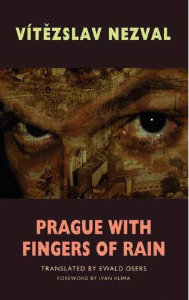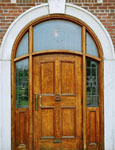Prague with Fingers of
Rain
Vitezslav Nezval
Translated by Ewald Osers
Bloodaxe Books, 2009
978-1-85224-816-1
62 pages
Reviewed by Christopher Doda

In this slender volume’s useful introduction by the Czech novelist Ivan Klima, he outlines the distinct phases of Vitezslav Nezval’s (1900-1958) prolific career from youthful proletarian poet to avant-garde proponent to post-World War Two state-protected writer. These poems were written in the 1930s after he had encountered and been heavily influenced by the Surrealist poetics of André Breton and Paul Eluard as had many Prague authors during the open period of Czechoslovak independence (Nezval, alongside Karel Teige, is credited with founding the first Surrealist group outside of France). Energetically translated by Ewald Osers, the poems of this period are widely considered his best. For anyone with an interest in the early avant-garde or European poetry in general it’s a relief to have these back in print (about half of these appeared back in 1971 as part of Three Czech Poets in Penguin’s long defunct yet wonderful Modern European Poets series).
During this time, Nezval’s subject matter was the dynamic city of Prague, one that he approached with a hedonistic sense of gusto. The opening poem, “City of spires”, like many of his works, features driving incantory repetition:
Hundred-spired Prague
With the fingers of all saints
With the fingers of perjury
With the fingers of fire and hail
With the fingers of a musician
With the intoxicating fingers of women lying on their backs
With fingers touching the stars
On the abacus of night
The effect is twofold. The city is displayed as a microcosm of all humanity, from “the fingers of cardsharpers and pincushions” to “the fingers clover and ancient monasteries” to the “fingers of the desecrated Host” to “fingers of naval ports and dancing lessons.” Also by equating the city’s numerous church spires to fingers, the poet is never distinct from the environment; he’s touched in all his senses. While 19th century Romantic and pastoral poets often presented themselves as remote or even otherworldly figures, Nevzal buried himself in his surroundings in order to create. In “Walker in Prague” a classic Baudelairean flaneur cannot come to terms with the city (“To climb and descend steps/Which lead nowhere/How often this nameless vertigo is conjured up”) until he embraces confusion and disorientation as normalcy:
Thus I learned to love Prague
Thus I first heard the bird singing under an art nouveau cornice of a shabby
square
Thus the pain of your inconsolable sadness faded away
Thus in the sickly suburbs I found my Cinderella
Thus I became a walker in Prague
Thus I learned to have dates in your streets with adventures and love
Prague of my dreams
which he describes as “miraculous as a fountain playing over a cemetery.”
Nezval’s reader experiences the city in all its plentiful facets. In “Covered market” the soul of Prague is revealed as feminine; men in “their tyranny” are “locked away in their offices” while women conduct essential, honest business out in the town square. As part of this anti-bureaucratic stance, the Czechoslovak women of “Old Prague” long for men outside of urbanity, for a “vision of a phantom horseman,” a figure out of rural mythology. “Prague in winter” reveals the citizenry isolated from their true, gregarious nature by harsh weather (“Instead of people all you see is hate frozen to foreheads”) because no one wishes for the unexpected interaction with their fellows in the deep cold, no one wants to talk: “As if there were no point in speaking/As if there were nothing to say/As if Prague were lost in an alien universe.”
In contrast, “Prague in the midday sun” shows the city in all its brightness and vivaciousness. This poem, late in the collection, ceases describing the city in lieu of forwarding an interpretation of what the city (or an idea of the city) means. With the clarity of daylight Nezval realizes that a multitude of urban experiences does not teach him to be a moral being but rather confirms what he innately knows: “I don’t expect love to reveal the universe or even this world.” He also acknowledges here that his views are highly subjective: Nezval sees Prague “through the filigree of trees as a maniac sees his phantasm.” However, there is a Humanist undercurrent:
I’ve no illusions about nations which rule the world or about
foreign settlements
I don’t regard the people whose language I speak as either better
or worse than those of other countries
I’m linked with the fate of the world’s disasters and only have a
little freedom to live or die
Here Nezval is one among thousands, among millions, tied to their overall fate but desiring to assert his own. In the final poem, “Prague with fingers of rain,” he attempts to fully come to terms with his beloved city yet finds the task impossible. Many of Nezval’s poems conclude on the notion of poetry itself as a byword to understanding (for instance, the aforementioned “City of spires” ends “With the fingers with which I am writing this poem”). It is fitting that the one poem that denies the poet’s ability to comprehend the city via his craft (“It is not in anything/Not in anything that can be explained in terms of beauty or style”) should close this book. And yet he makes the plea that every poet makes, either secretly or out in the open (and makes it beautifully): to be heard
To future generations I bequeath my experience and a long sigh
For the unfinished song which wakes me which lulls me to sleep
Remember me
That I lived and walked about Prague
That I learned to love her in a way no one loved her before
It’s worth noting that, like with everything else, Nezval ties the possible longevity of his poetic enterprise to his acute sense of place. I’ve rarely read a poet capable of such thorough love letters to the completeness of urban life. Long may he be read.













